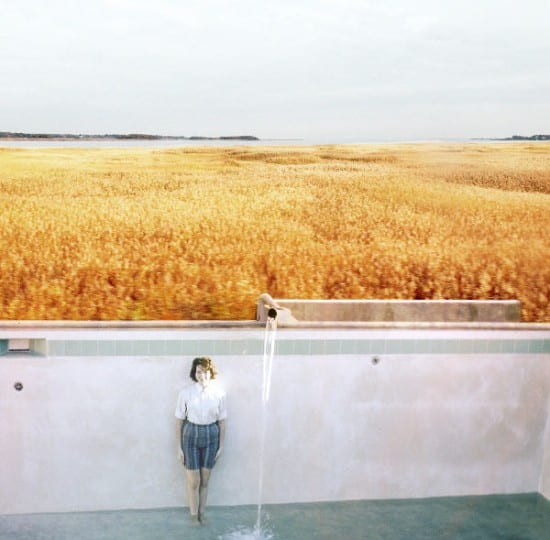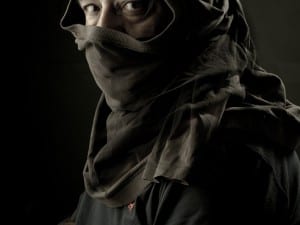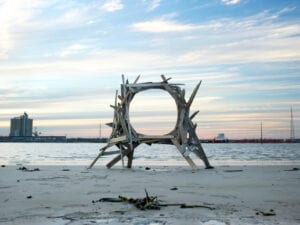“Illusion does not free us from reality. Ironically, through employing the very medium I critique, my work speaks to the disenchantment of the social psyche, which takes place at the hands of the modern media apparatus and at the expense of the natural world.” Through photography Sam Heydt comments on consumerism and constructed narratives of the past with a concern for the perversity of production, consumption and decay. We speak to Heydt about her ideas and what inspired her work Chrysanthemums in particular, selected for the Aesthetica Art Prize Anthology 2014.
A: What was the inspiration for Chrysanthemums?
SH: Consistently working from a position of truth, or lived experience, I use photography as a means to mediate my own experiences and find new ways of questioning or understanding what I see. Conflating the past and present, Chrysanthemums was inspired by the visceral appeal of the photographic medium and its problematic relationship with reality.
Although no object is counted on more for its mnemonic technology, a photograph provides a carbon copy of an instance that exists on a separate plane to memory, as recollections of the past are dictated by the present. Playing with the construct of the photographic process, the recycling of appropriated imagery and the re-representation of a moment, I used collage intervention to disrupt the singularity of the time and place captured. The positivist discourse of photography’s relationship with truth deteriorates with the seamless layering of these temporally estranged images — usurping the pretense of the original moment.
A: What do you hope a viewer will take from your photographs?
SH: My work aims to convey the different phenomenologies of our increasingly fractured social landscape, the mutability of history and material inequalities of a world reduced to a bottom line. Although I am very conscious of how my photographs may translate, I don’t like to dictate how my viewers should feel about the work. Art is a product of lived experiences; how it is understood is hinged on the perception of the audience. Imagery functions in both directions: while photographers bring their own history, politics and neurosis to the picture, the viewer inevitably meets it with their own personal biases and convictions. In my experience as an image maker, it is banality and ambiguity that have that transcendental quality semiotically accessible to a wider audience.
This is the poetry of the enclosure and at the same time the prosaic phenomenon of the minds’ ability to draw upon personal experience, no matter how resistant. With that said, having spent the last decade documenting mines, landfills, deforestation and other scarred landscapes, I hope the socially conscious work I’ve done speaks for itself and brings to forefront of people’s contemplation imagery that transcends their site-specific locations.
A: Which artists have inspired your practice?
SH: Although a Warholian at heart, as a child I was inspired by Tamara de Lempicka and Egon Schiele, as well as Fauvist painters like Matisse whose bold palette has since informed the way I see colour. As far as photographers go, Robert Capa’s kinetic documentary work and the different approaches taken by Diane Arbus and Richard Avedon to portraiture have definitely made their mark. The highly saturated prints of Andreas Gursky also come to mind, as do Andrea Burtynsky’s monumental depictions of man’s intervention on nature. I am also drawn to the diaristic style of Nan Goldin and the work of Stephen Shore. The cinema continually inspires me as well – David Lynch and Stanley Kubrick being the most notable influences.
A: You have lived and worked in Paris, Amsterdam, Buenos Aires, Venice, Athens and Istanbul. How has traveling influenced your work?
SH: My work addresses my own life; my social, political, and environmental anxieties – the world around me. As a photographer, I feel that it is my responsibility to continuously expand my frame of reference and move out of my comfort zone. My experience out in the world has opened my mind, challenged my perspective and renewed my sense of the essential and the possible. It has taught me to be present, to look at things more intimately, to have faith in others and myself. Traveling has also allowed me to build an international audience and engage in new ways with the world around me.
A: Do you have any future projects at your studio, Jane Street Studio in Manhattan?
SH: This year Jane Street Studio has transformed and expanded its market into Europe and Australia, by executing shoots around the world, from the Blue Mountains of Australia to the Thar desert in Rajasthan, India. We’ve also been doing some PR, design and marketing projects, with a focus toward redesigning the scope and scale of what Jane Street Studio can be. I’m interested in intertwining the commercial aspect of Jane Street Studio with my own personal fine art. For instance, I am now represented in Australia and Asia by Noella Lopez Gallery – an exciting collaboration I am looking forward to, which suits the direction my practice is taking.
While in-studio, high fashion photography put Jane Street on the map, the studio is consciously moving quickly towards projects with an emphasis on international partnerships and culturally/politically conscientious ventures. My hope is to produce a documentary in Cuba this upcoming year. I would also like to use Jane Street as a vehicle for raising funds to open an orphanage in India aimed towards educating and empowering girls.
To see more of Sam Heydt’s work visit www.samheydt.com and follow @SamHeydt.
Follow us on Twitter @AestheticaMag for the latest news in contemporary art and culture.
Credits
1. Sam Heydt, Chrysanthemums. Courtesy of the artist.





